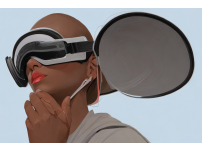가상현실(VR)이 피트니스 산업에 미치는 영향: 운동 및 훈련 강화(The Impact of Virtual Reality on…
본문
가상 현실(VR) 기술은 운동과 훈련을 향상시키는 새롭고 혁신적인 방법을 제공하면서 피트니스 산업을 빠르게 변화시키고 있습니다. VR은 피트니스 매니아들에게 더욱 몰입적이고 매력적인 운동 경험을 제공할 수 있는 능력을 가지고 있으며, 이는 그들이 그들의 피트니스 목표에 동기를 부여하고 집중할 수 있도록 도와줍니다.
VR이 피트니스 산업에서 사용되는 주요 방법 중 하나는 운동을 강화하는 것입니다. VR은 야외 환경을 시뮬레이션하는 데 사용될 수 있으며, 사용자가 가상 현실 사이클링, 달리기 및 기타 형태의 운동에 참여할 수 있습니다. 이는 사용자가 운동하는 동안 가상 환경의 광경과 소리를 경험할 때 동기 부여와 참여를 유지하는 데 도움이 될 수 있습니다. 또한 VR은 사용자에게 가상 트레이너와 코치를 제공하여 사용자가 체력 목표를 달성할 수 있도록 도와줍니다.
VR은 또한 운동선수와 피트니스 매니아에게 보다 몰입적이고 상호작용적인 훈련 경험을 제공하면서 훈련을 향상시키는 데 사용되고 있습니다. 예를 들어, VR은 사용자가 안전하고 통제된 환경에서 기술과 기술을 연습할 수 있도록 하는 스포츠 환경을 시뮬레이션하는 데 사용될 수 있습니다. 이를 통해 사용자는 실제 시나리오에 적용하기 전에 가상 환경에서 경험을 쌓고 기술을 개발할 수 있으므로 성능을 향상시키고 부상 위험을 줄일 수 있습니다.
한국에서, 피트니스 산업은 여러 피트니스 센터와 체육관이 그들의 운동과 훈련 프로그램에 VR을 통합하면서 VR 기술을 채택했습니다. 예를 들어, 몇몇 한국의 체육관들은 가상 현실 사이클링에 참여하고 그들이 운동하는 동안 가상 환경의 광경과 소리를 즐길 수 있도록 하는 VR 사이클링 시스템을 설치했습니다. 게다가, 한국 피트니스 센터들은 사용자들에게 가상 트레이너와 코치를 제공하기 위해 VR을 사용하고 있으며, 이는 사용자들이 피트니스 목표를 달성할 수 있도록 도와줍니다.
결론적으로, VR 기술은 운동과 훈련을 향상시키는 새롭고 혁신적인 방법을 제공하면서 피트니스 산업을 변화시키고 있습니다. VR 기술이 계속 발전함에 따라, 우리는 피트니스 업계에서 훨씬 더 많은 기술 적용을 보게 될 것이며, 피트니스 애호가들의 운동과 훈련 경험을 더욱 향상시킬 것입니다.
또한, VR 기술은 원격 교육 및 원격 건강에 새로운 기회를 제공하고 있습니다. 이를 통해 사용자는 신체적 위치에 관계없이 운동을 하고 원격 트레이너로부터 코칭과 지원을 받을 수 있습니다. 이것은 특히 시골 지역에 거주하거나 전통적인 피트니스 시설이나 트레이너를 이용할 수 없는 이동 장애가 있는 사람들에게 유용합니다.
피트니스 산업에서 VR의 또 다른 장점은 개인의 필요와 선호에 따라 운동과 훈련 프로그램을 맞춤화할 수 있는 능력입니다. 예를 들어, 사용자는 참여하고 싶은 운동 유형을 선택하고, 가상 환경을 선택하고, 자신의 피트니스 목표를 설정할 수 있습니다. 이러한 수준의 사용자 정의는 사용자가 운동 및 훈련 경험을 보다 효과적으로 제어할 수 있기 때문에 사용자의 동기를 유지하고 피트니스 여행에 참여시키는 데 도움이 될 수 있습니다.
그러나 다른 기술과 마찬가지로 피트니스 업계에서도 VR 사용과 관련된 과제가 있습니다. 예를 들어, VR 하드웨어와 소프트웨어는 피트니스 애호가와 체육관 모두에게 채택될 수 있도록 신뢰할 수 있고 사용자 친화적이며 경제적이어야 합니다. 또한, 사용자가 부상 위험 없이 VR 운동과 훈련을 할 수 있도록 안전 지침을 수립하고 준수할 필요가 있습니다.
결론적으로, VR 기술은 운동과 훈련을 향상시키는 새롭고 혁신적인 방법을 제공하면서 피트니스 산업을 변화시키고 있습니다. 더 몰입적이고 매력적인 운동 경험, 원격 훈련 및 원격 건강, 또는 운동 및 훈련 프로그램을 사용자 지정할 수 있는 능력을 통해 VR은 사람들이 운동하는 방식을 혁신하고 피트니스 목표를 달성할 수 있는 잠재력을 가지고 있습니다. VR의 이점은 아직 해결해야 할 과제가 있지만, 피트니스 업계의 기업과 개인이 탐색할 가치가 있는 기술입니다.
Virtual Reality (VR) technology is rapidly transforming the fitness industry, offering new and innovative ways of enhancing workouts and training. VR has the ability to provide fitness enthusiasts with a more immersive and engaging workout experience, helping to keep them motivated and focused on their fitness goals.
One of the key ways VR is being used in the fitness industry is to enhance workouts. VR can be used to simulate outdoor environments, allowing users to engage in virtual reality cycling, running, and other forms of exercise. This can help to keep users motivated and engaged, as they experience the sights and sounds of a virtual environment while they exercise. Additionally, VR can also be used to provide users with virtual trainers and coaches, helping to keep them on track with their fitness goals.
VR is also being used to enhance training, providing athletes and fitness enthusiasts with a more immersive and interactive training experience. For example, VR can be used to simulate sports environments, allowing users to practice their skills and techniques in a safe and controlled environment. This can help to improve performance and reduce the risk of injury, as users are able to gain experience and develop their skills in a virtual environment before applying them in real-world scenarios.
In Korea, the fitness industry has embraced VR technology, with several fitness centers and gyms incorporating VR into their workout and training programs. For example, several Korean gyms have installed VR cycling systems, allowing users to engage in virtual reality cycling and enjoy the sights and sounds of a virtual environment while they exercise. Additionally, Korean fitness centers are also using VR to provide users with virtual trainers and coaches, helping to keep them on track with their fitness goals.
In conclusion, VR technology is transforming the fitness industry, offering new and innovative ways of enhancing workouts and training. As VR technology continues to evolve, it is likely that we will see even more applications of the technology in the fitness industry, further improving the workout and training experiences for fitness enthusiasts.
Additionally, VR technology is also providing new opportunities for remote training and telehealth. This allows users to exercise and receive coaching and support from remote trainers, regardless of their physical location. This is especially beneficial for people living in rural areas or with mobility challenges who may not have access to traditional fitness facilities or trainers.
Another advantage of VR in the fitness industry is the ability to customize workouts and training programs to individual needs and preferences. For example, users can select the type of workout they want to engage in, choose their virtual environment, and set their own fitness goals. This level of customization can help to keep users motivated and engaged in their fitness journeys, as they have greater control over their workout and training experience.
However, as with any technology, there are also challenges associated with the use of VR in the fitness industry. For example, there is a need for VR hardware and software to be reliable, user-friendly, and affordable, so that it can be adopted by fitness enthusiasts and gyms alike. Additionally, there is a need for safety guidelines to be established and adhered to, so that users can engage in VR workouts and training without risk of injury.
In conclusion, VR technology is transforming the fitness industry, offering new and innovative ways of enhancing workouts and training. Whether it's through providing a more immersive and engaging workout experience, remote training and telehealth, or the ability to customize workouts and training programs, VR has the potential to revolutionize the way people exercise and achieve their fitness goals. While there are still challenges to be addressed, the benefits of VR make it a technology worth exploring for businesses and individuals in the fitness industry.














댓글목록 0